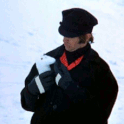Author Notes
I love rustic Italian ragùs made with game. Much of the time I’ve spent in Italy has been in woodsy locales in Umbria and Tuscany, awakening to the sound of gun shots as hunters blasted away at stuff running through the fields or flying in the air. For some reason waterfowl seldom seemed to be involved despite Italy’s many lakes. In researching duck recipes (anatra or papera) most I looked at came from either the Veneto (and had more in common with France) or from the Abruzzo. My recipe is I think closer to the latter style, although I use many of the same elements I would for an Umbrian ragù.
Most such ragùs use olive oil. But, because when buying duck breasts, I’ve found that the weight is about half skin and fat, as a frugal cook I like to incorporate both rather than waste them. But care needs to be taken in rendering the fat.
“Paperino” is “Donald Duck” in Italy in case you care.
—pierino
Ingredients
-
1 1/2 pounds
boneless duck breast with skin
-
1
medium red onion, chopped
-
1
carrot chopped in small dice
-
1
clove garlic, crushed and chopped
-
1
small branch rosemary (leaves stripped off and finely chopped)
-
3
-5 fresh sage leaves, roughly chopped
-
1/2
stick cinnamon
-
5
-6 juniper berries, about 1 tablespoon
-
5
whole cloves
-
8
black (or white) peppercorns
-
1 tablespoon
balsamic vinegar (I use fig balsamic but that’s a minor nuance)
-
1 tablespoon
tomato paste (you buy it in the tube, right?)
-
1
splash Grand Marnier (optional)
-
1/2 cup
dry red wine
-
1 cup
poultry stock (ideally, duck stock but a brown chicken stock is fine)
-
1 tablespoon
fresh grated orange zest
-
1
9-10 ounce package of pappardelle pasta (Rustichella d’Abruzzo brand highly preferred)
-
Grated pecorino cheese
Directions
-
Prepare your mise en place of onion, carrot and garlic
-
In your cro-magnon mortar grind up the juniper, cinnamon, rosemary, peppercorns and cloves together. Or use a spice grinder. Just don’t turn them into gun powder.
-
Now address the duck. “Good afternoon, Paperino.” “Ppphhwwwwaaaaapphqquaccccckkkkk, AFLAC”!
-
Remove the skin and fat from the duck breasts. You can accomplish most of this bare knuckled but use a sharp knife to trim any stragglers. With that same sharp knife cut the meat into ¼” bits. They don’t have to be totally uniform. DO NOT DISCARD THE SKIN!
-
Heat up the heavy pot in which you will cook your ragù over medium flame. Place the skin pieces fat side down in the pot. Remain vigilant. Render as much fat as you can from the skin, working vigilantly. Duck fat has a low smoke point so don’t let the skin pieces burn or you will have to discard the oil and start over, because your ragù will be very bitter if you fail to pay attention. When you think you have rendered as much fat as possible remove the skins and set aside. There should be a lot of fat here. Off heat ladle out all but about 2 tbs of that fat. But ladle that stuff into a jar or something and refrigerate. It’s like holding a little bit of gold in your fridge. Great for frying potatoes in, so don’t waste it.
-
Return the pot to heat and add your mise. Season with salt and pepper as you go. Give it some color and push to the back of the pot. Add the duck and color that as well, but don’t brown it or it will become way too chewy. Add the splash of Grand Marnier (if using) and let the alcohol cook off.
-
Stir in the herbs and tomato paste and aromatize your kitchen. Let this cook for five minutes or so.
-
Add the vinegar, followed by the wine. Add the stock. Taste for salt. Reduce to a simmer. Cover and allow to cook for up to two hours. This tends to be a wet sauce.
-
Cook the pasta
-
Zest the orange and add that to the ragù.
-
Plate up the pasta. Top with a ladle of ragu and grating of pecorino on each individual plate.
-
Notes to cook: I’m serious about not burning the skin. I’ve done it accidentally and now I don’t. Pay attention to that. Please don’t waste that wonderful duck fat. Also, I kind of like to toss at least one piece of that skin into the ragu as it simmers down, just amping up the duck flavor. You don’t have to serve it, you can discard it like a bay leaf after, but you might want to consider the technique.
-
....the recommended pasta, “Rustichella d’Abruzzo” is the best dried pasta in all of Italy. Their extruded shapes are still made using bronze (as opposed to Teflon) dies. It’s more expensive than Ronzoni or Barilla of course but worth it. If you are an able hand at making pappardelle from scratch, by all means go at it. I do from time to time. But this is one of those cases where the pasta is so good that you shouldn’t have to bother. Probably 90% of the ristoranti, trattorie, osterie in Italy use commercial pasta. I can name some that don’t.
Standup commis flâneur, and food historian. Pierino's background is in Italian and Spanish cooking but of late he's focused on frozen desserts. He is now finishing his cookbook, MALAVIDA! Can it get worse? Yes, it can. Visit the Malavida Brass Knuckle cooking page at Facebook and your posts are welcome there.


See what other Food52ers are saying.